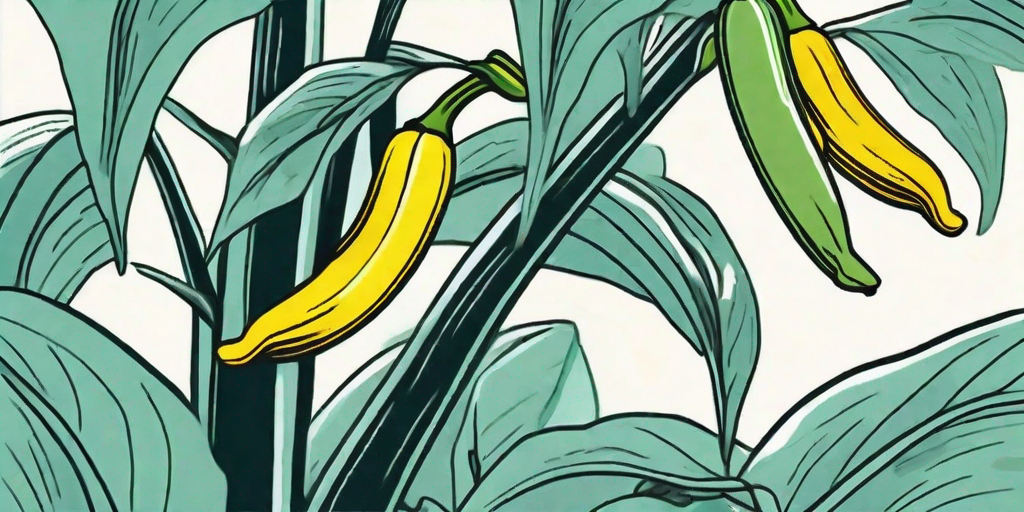
Are you tired of the same old tomatoes and cucumbers in your garden? Looking for a new, exciting addition that will not only add a splash of color but also a burst of flavor to your dishes? Well, look no further than the humble banana pepper plant. This cheeky little plant is not only easy to grow, but it also produces a bounty of delicious peppers that can be used in a variety of dishes. So, let's dive in and explore the world of banana peppers.
Understanding the Banana Pepper Plant
First things first, let's get to know our new garden buddy a little better. The banana pepper, also known as the yellow wax pepper, is a member of the chili pepper family. Despite its name, it has nothing to do with bananas, except for its yellow color and curved shape. It's a mild pepper, perfect for those who like a little spice but not too much heat.
The banana pepper plant is a warm-weather crop, thriving in temperatures between 70 and 85 degrees Fahrenheit. It's a relatively small plant, usually growing to about 1-2 feet in height, making it a perfect fit for any garden, no matter how small.
The Life Cycle of a Banana Pepper Plant
Like all plants, the banana pepper plant has a specific life cycle. It starts as a seed, sprouts into a seedling, grows into a mature plant, produces fruit, and then dies back in the winter. This cycle typically takes about 70-80 days, depending on the growing conditions.
One of the best things about the banana pepper plant is that it's a prolific producer. Once the plant starts bearing fruit, you can expect to harvest peppers every 2-3 weeks until the first frost. That's a lot of peppers!
How to Grow a Banana Pepper Plant
Now that we've gotten to know the banana pepper plant a little better, it's time to get our hands dirty and learn how to grow one. Don't worry, it's not as hard as it sounds. In fact, with a little care and attention, you'll be a banana pepper pro in no time.
First, you'll need to decide whether you want to start your plants from seeds or buy seedlings from a nursery. Both options have their pros and cons, but starting from seeds gives you a greater sense of accomplishment. Plus, it's cheaper!
Starting from Seeds
If you decide to start from seeds, you'll need to begin indoors about 8-10 weeks before the last expected frost. Plant the seeds in a seed-starting mix, cover with a thin layer of soil, and keep them warm and moist. Once the seedlings have two sets of true leaves, they're ready to be transplanted into the garden.
When transplanting, make sure to harden off the seedlings first. This involves gradually exposing them to outdoor conditions over a week or two to prevent shock. Once hardened off, plant the seedlings in a sunny spot in the garden, spacing them about 18-24 inches apart.
Starting from Seedlings
If you decide to start from seedlings, the process is much simpler. Simply choose healthy-looking plants from a nursery, harden them off, and plant them in the garden. Easy peasy!
How to Care for Your Banana Pepper Plant
Once your banana pepper plants are in the ground, they'll need some TLC to thrive. This includes regular watering, fertilizing, and pest control.
Water your plants regularly, but be careful not to overwater. Too much water can lead to root rot and other diseases. A good rule of thumb is to water when the top inch of soil is dry.
As for fertilizing, a balanced vegetable fertilizer should do the trick. Apply according to the package instructions, usually once at planting time and again when the plants start to flower.
Dealing with Pests and Diseases
Like all plants, banana peppers can be susceptible to pests and diseases. Common pests include aphids, cutworms, and spider mites, while common diseases include bacterial spot and mosaic virus.
The best defense against pests and diseases is a healthy plant. Regular watering, fertilizing, and proper spacing can go a long way in preventing problems. If you do notice pests or disease, act quickly to prevent them from spreading.
Harvesting and Using Your Banana Peppers
Now for the fun part - harvesting and using your banana peppers! Banana peppers can be harvested at any stage, but they're usually picked when they're yellow and about 6-8 inches long.
To harvest, simply cut the peppers off the plant with a pair of scissors or pruning shears. Be careful not to pull or twist the peppers, as this can damage the plant.
Once harvested, banana peppers can be used in a variety of dishes. They're great in salads, stir-fries, and sandwiches, or they can be pickled for a tangy treat.
FAQs
Are banana peppers hot?
No, banana peppers are considered a mild pepper. They have a Scoville heat unit rating of 0-500, which is much lower than other chili peppers.
Can I grow banana peppers in a pot?
Yes, banana peppers are perfect for container gardening. Just make sure the pot is at least 12 inches in diameter and has good drainage.
How long does it take for banana peppers to grow?
From seed to harvest, it usually takes about 70-80 days for a banana pepper plant to grow.
Conclusion
So there you have it, a comprehensive guide to growing and harvesting banana peppers. With a little care and attention, you can spice up your garden and your dishes with this versatile plant. So why not give it a try? Your taste buds will thank you!











